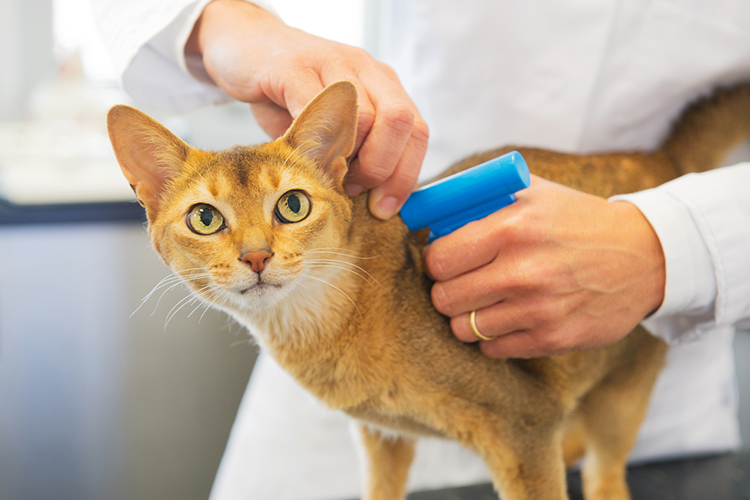Welcome to the future! We have palm-sized computers, vacuums that run themselves, a robot on Mars, and tiny chips we can put under our pet’s skin so they don’t get lost and stay lost. We’re talking about microchips, y’all, and giving you the 411 on microchipping your feline friends.
What is microchipping?
Microchipping is magic. Okay, it’s not really – it’s technology at its best. By implanting a small RFID chip underneath the skin of your cat, you’re creating a link between you that can’t be broken by a lost kitty and a lost collar. These radio-frequency identification chips are approximately the size of a grain of rice and, when read by an appropriate scanner, provide a unique number. This unique number is registered in a database with your name, phone number, address, and various other information. If your cat is lost, any shelter or vet’s office can check for a microchip, get your unique number, then call the correct microchip service—the service gets in contact with you and your kitty is returned from any disappearing trick gone awry!
Since your personal information is registered with a microchip service like PetLink or 24PetWatch, not directly engraved on a removable collar, your privacy is protected. It’s also important to understand that a RFID microchip is not a tracking device – you won’t have an app that lets you track your cat’s location in real-time like you’re operations control and they’re secret agents on a mission. (Hollywood, you’re welcome for the movie idea. I accept payment via check or cat food.) Still, it’s a cost-effective and brilliant precaution to take in ensuring your cat always finds her way home.
How is microchipping done?
Incredibly easily! In fact, microchipping is a snap and doesn’t require any anesthesia. These RFID chips come pre-loaded in sterile syringes for your vet or shelter’s use, and implantation is completed as quickly as any other shot. Vets will most commonly inject the microchip between a cat’s shoulder blades, though there is no standardized placement. That’s it! It’s noninvasive, not particularly painful, and should be relatively low-cost.
The cost can vary, of course, so check with your vet. However, many shelters these days fold the cost of microchipping in with spaying or neutering to attract adopters. My husband and I recently adopted a tiny calico kitten—the adoption fee was $50, and she’d already been spayed and micro chipped. (We named her Rey, and now can’t stop referring to the pet store as Jakku.)
But can anything go wrong?
There’s not a lot that can go wrong, and negative reactions to the microchip are rare. In a very small number of cases, a tumor has developed at the implantation site – however, this is so incredibly rare that the potential harm does not outweigh the potential benefit.
Occasionally, the microchip may migrate away from the implantation site. However, it’s only just under the skin so it can’t penetrate or damage any organs. The greater concern is that your cat may be lost and a clinic or shelter might miss the microchip. Since migration is a known concern, though, many professionals will scan all over a cat’s body when checking for a microchip. (This is something you can keep tabs on when you take your cat in for their yearly check-up. Just have your vet scan to make sure it’s still in place.)
My cat is microchipped! What next?
Once your cat’s been microchipped, you MUST register with the service who provided the microchip! You should receive instructions either as a print-out or via email from your vet or the shelter. For example, when we adopted Rey, we provided the shelter with our email address. They emailed us a couple of days later with Rey’s microchip number and instructions on where to register our information. And remember: ALWAYS keep your information with the microchip service up to date! Any time you get a new phone number or move to a new address, update your microchip service. It’s no use living in a cool science fiction future if we fall prey to outdated information.
Now, if your outdoor cat ranges too far from home or your indoor cat decides to explore the great outdoors and gets lost—they have a way to come back to you. If they’re taken to a vet or a shelter, their microchip can be scanned and your kitty will phone home.
Maybe microchips are a kind of magic after all.







So if socks vanishes like my Scottish Fold Tilly. I actually cannot knock on a door and demanding my cat. Back. It depends on someone”s kindness. Hit or miss. For this I pay up to 50.00$..Ain’t gonna happen. People could care less about.a stray cat.